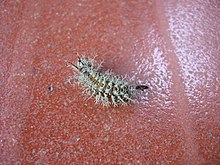Lonomia
| Lonomia | |
|---|---|
 |
|
| Lonomia sp. moth | |
 |
|
| Caterpillar of Lonomia obliqua | |
| Scientific classification | |
| Kingdom: | Animalia |
| Phylum: | Arthropoda |
| Class: | Insecta |
| Order: | Lepidoptera |
| Family: | Saturniidae |
| Subfamily: | Hemileucinae |
| Genus: |
Lonomia Walker, 1855 |
| Species | |
|
See text |
|
| Diversity | |
| 14 species | |
See text
The genus Lonomia is a moderate-sized group of fairly cryptic saturniid moths from South America, famous not for the adults, but for their highly venomous caterpillars, which are responsible for a few deaths each year, especially in southern Brazil, and the subject of hundreds of published medical studies. They are commonly known as Giant Silkworm Moth, a name also used for a wide range of other Saturniid moths.
The caterpillars are themselves extremely cryptic, blending in against the bark of trees, where the larvae commonly aggregate. The larvae, like most hemileucines, are covered with urticating hairs, but these caterpillars possess a uniquely potent anticoagulant venom.
A typical envenomation incident involves a person unknowingly leaning against, placing their hand on, or rubbing their arm against a group of these caterpillars that are gathered on the trunk of a tree. The effects of a dose from multiple caterpillars can be dramatic and severe, including massive internal hemorrhaging, renal failure, and hemolysis. The resulting medical syndrome is sometimes called Lonomiasis.
The LD50 of the Lonomia venom is 0.19 mg for an 18-20 g mouse (IV); however, due to the small amount of venom in the bristles of the caterpillar, the rate of human fatality is only 1.7%.
While there are more than a dozen species in the genus, the most troublesome species is Lonomia obliqua, and it is this species on which most of the medical research has centered. As anticoagulants have some very beneficial applications (e.g., prevention of life-threatening blood clots), a fair bit of the research is motivated by the possibility of deriving some pharmaceutically valuable chemicals from the toxin.
...
Wikipedia
